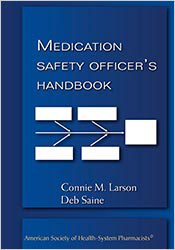For more information on these two initiatives please visit the following:
The six priority domains of the NQS deemed measureable by NQF are listed below, each with a demonstrative example of how pharmacists can engage in improving healthcare quality. At the end of the page you will find links to commonly referred ASHP best practices and ASHP resources. ASHP's official statement on the health-systems pharmacist's role in national health care quality initiatives can be found at Health-System Pharmacists Role in National Health Care Quality Initiatives [PDF].
Six Priority Domains of the National Quality Strategy:
- Work with communities to promote wide use of best practices to enable healthy living and well-being. In one study heart failure patients 50 years of age or older with low socioeconomic status and health literacy were randomly assigned to pharmacist-intervention or usual care groups and followed for 12 months. Among patients who received pharmacist-provided medication management, medication adherence was significantly increased, while emergency department visits and hospital admissions were decreased 19.4% Annual direct health care costs were also decreased in the intervention group. See Murray MD, Young J, Hoke S, et al. Pharmacist intervention to improve medication adherence in heart failure: a randomized trial. Ann Intern Med. 2007;146(10):714-25.
- Promote the most effective prevention, treatment and intervention practices for the leading causes of mortality, starting with cardiovascular disease. A hospital-wide clinical pharmacy education program increased utilization of venous thromboembolism prophylaxis in medical patients in a community teaching hospital from 43% to 58%. See Dobesh PP, Stacy ZA. Effect of a clinical pharmacy education program on improvement in the quantity and quality of venous thromboembolism prophylaxis for medically ill patients. J Manag Care Pharm. 2005;11(9):755-62. [PDF]
- Ensure person-and family-centered care. A pharmacist—nurse team intervention resulted in a significant drop in blood pressure even among patients with diabetes and hypertension whose disease was relatively well controlled.Care and tools provided by the pharmacist—nurse team included a blood pressure wallet card, cardiovascular risk reduction education and counseling, referral to the patient's primary care physician, a 1-page summary sent to the physician reinforcing guidelines for hypertension and diabetes, and four follow-up visits throughout a 6-month period. Patients in the control group received a wallet card, pamphlets, general diabetes advice, and usual care by their physician. The intervention group had a greater reduction in blood pressure at 6 months compared with patients in the control group (p=.008). See McLean DL, McAlister FA, Johnson JA, et al. A randomized trial of the effect of community pharmacist and nurse care on improving blood pressure management in patients with diabetes mellitus: study of cardiovascular risk intervention by pharmacists. Arch Intern Med. 2008;168(21):2355-61.
- Make care safer through the following
- Reduce preventable hospital admissions and readmissions
- Reduce the incidence of adverse healthcare-associated conditions
- Reduce harm from inappropriate or unnecessary care
- Promote effective communication and care coordination through the following
- Improve the quality of care transitions and communications across care settings
- Improve the quality of life for patients with chronic illness and disability by following a current care plan that anticipates and addresses pain and symptom management, psychosocial needs, and functional status.
- Establish shared accountability and integration of communities and healthcare systems to improve quality of care and reduce health disparities.
- Make quality care affordable for people, families, employers, and governments. An AHRQ-funded study showed that a comprehensive patient-discharge plan that included follow-up from a pharmacist decreased subsequent hospital visits by approximately 30%. Two to four days after discharge, a clinical pharmacist contacted patients in the intervention group to review and reinforce the discharge plan. The intervention group demonstrated an estimated $150,000 in savings in emergency department, hospital, and primary care visits, or approximately $412 per patient. See Jack B, Chetty V, Anthony D, et al. A reengineered hospital discharge program to decrease rehospitalization: A randomized trial. Ann Intern Med 2009; 178-87.


